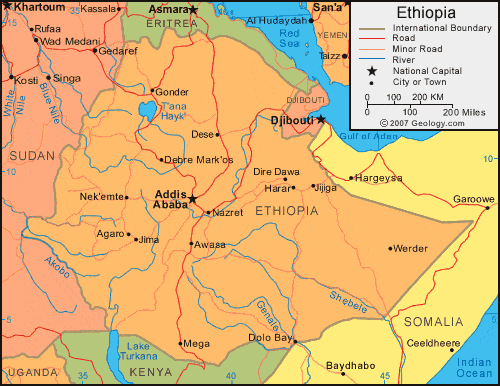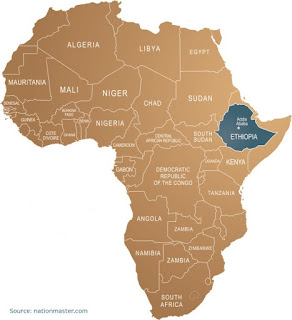Ethiopian Background Update
It’s occurred to me that since my decision to focus on Ethiopia I haven’t really given much general information about the country. However, I think it will be really useful for putting the challenges and possible solutions that I’ll be discussing into context. So here’s a quick background update on Ethiopia:
Despite being influenced by processes in the Indian Ocean, Ethiopia is a landlocked nation (see Figure 1). It has the second largest population of any African country, behind Nigeria, yet it is also one of the most poverty stricken with a per capita income of just $660. Agriculture makes up almost 50% of the country’s GDP, most of which centres on small-scale rain-fed crops and livestock rearing, and is growing at 5% per year. Economic growth averaging 10.5% per year from 2005/6 to 2015/16 has, however, reduced extreme poverty levels from 55.3% in 2000, to 33.5% in 2011. Alongside this, in the last 20 years Ethiopia has seen a marked improvement in a number of human development indicators. Child mortality, for example, has been halved, access to clean water has increased more than two fold, primary school attendance has risen four fold and life expectancy has risen to just over 65.
Additionally, Ethiopia has established the most extensive social safety net programme in Africa and has ambition to transition to a lower-middle-income nation by 2025. There has been increasing public spending over the last decade and remarkable advances have been made in health sectors and general service provision, with 42% of the urban population reaping the benefits. There is still, however, a long way to go and, largely as a result of the country’s very low starting position, Ethiopia still needs substantial investment and improved policies in order to achieve their development ambitions. Furthermore, whilst great progress has been made, it is important to remember that a 33.5% extreme poverty level is still substantial and, when put in the context of Ethiopia's population growth rate of 3.2%, means the actual number of Ethiopians living in extreme poverty has grown. Despite Ethiopia’s impressive social safety net programme, there remains serious concerns over its food security and, as I’ll be discussing in future posts, improvements could be made to water management for agricultural production. As I mentioned in my last post, next week I’ll be having a look at the effects on food availability of natural and anthropogenic fluctuations in rainfall.
 |
| Figure 1: Political Map of Ethiopia |



Hi Henry,
ReplyDeleteI think it's a wise choice to focus on a country within Africa and really going into depth, instead of trying to focus on all or most of the countries briefly. I was just wondering, in your opinion, are there any other African countries which have similar characteristics to Ethiopia. I am asking this question to see whether any policy recommendations you make can be transferred elsewhere. Or would you say that every country is truly unique and there is no one size fits all policy?
Best wishes,
Anparasan
Hi Anparasan, thanks for reading and the feedback.
ReplyDeleteI do think that there are similarities across certain countries in Africa, particularly in terms of the socioeconomic capacity of implementing development strategies. However I would be cautious about offering general statements, assumptions or policy recommendations without looking in depth at each individual country, as ultimately, each country may be highly varied whether this be in terms of precipitation or groundwater availability.
This is not to say policies offered for one place cannot be looked at, used or adapted for a different country, but I would be hesitant in using a policy without first looking in detail at each individual country.
Thanks,
Henry